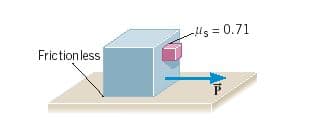he drawing shows a cube (mass=26.6kg), being accelerated across a horizontal frictionless surface by a horizontal surface P. A small cube (mass= 4.4kg) is in contact with the front surface of the large cube and will slide downward unless P is sufficiently large. The coefficient of static friction between the cubes is 0.710. What is the smallest magnitude that P can have in order to keep the small cube from sliding downward?
he drawing shows a cube (mass=26.6kg), being accelerated across a horizontal frictionless surface by a horizontal surface P. A small cube (mass= 4.4kg) is in contact with the front surface of the large cube and will slide downward unless P is sufficiently large. The coefficient of static friction between the cubes is 0.710. What is the smallest magnitude that P can have in order to keep the small cube from sliding downward?
University Physics Volume 1
18th Edition
ISBN:9781938168277
Author:William Moebs, Samuel J. Ling, Jeff Sanny
Publisher:William Moebs, Samuel J. Ling, Jeff Sanny
Chapter6: Applications Of Newton's Laws
Section: Chapter Questions
Problem 131CP: A car of mass 1000.0 kg is traveling along a level road at 100.0 km/h when its brakes are applied....
Related questions
Topic Video
Question
The drawing shows a cube (mass=26.6kg), being accelerated across a horizontal frictionless surface by a horizontal surface P. A small cube (mass= 4.4kg) is in contact with the front surface of the large cube and will slide downward unless P is sufficiently large. The coefficient of static friction between the cubes is 0.710. What is the smallest magnitude that P can have in order to keep the small cube from sliding downward?

Transcribed Image Text:Friction less
-Hs = 0.71
Expert Solution
This question has been solved!
Explore an expertly crafted, step-by-step solution for a thorough understanding of key concepts.
This is a popular solution!
Trending now
This is a popular solution!
Step by step
Solved in 3 steps with 7 images

Knowledge Booster
Learn more about
Need a deep-dive on the concept behind this application? Look no further. Learn more about this topic, physics and related others by exploring similar questions and additional content below.Recommended textbooks for you

University Physics Volume 1
Physics
ISBN:
9781938168277
Author:
William Moebs, Samuel J. Ling, Jeff Sanny
Publisher:
OpenStax - Rice University

University Physics Volume 1
Physics
ISBN:
9781938168277
Author:
William Moebs, Samuel J. Ling, Jeff Sanny
Publisher:
OpenStax - Rice University